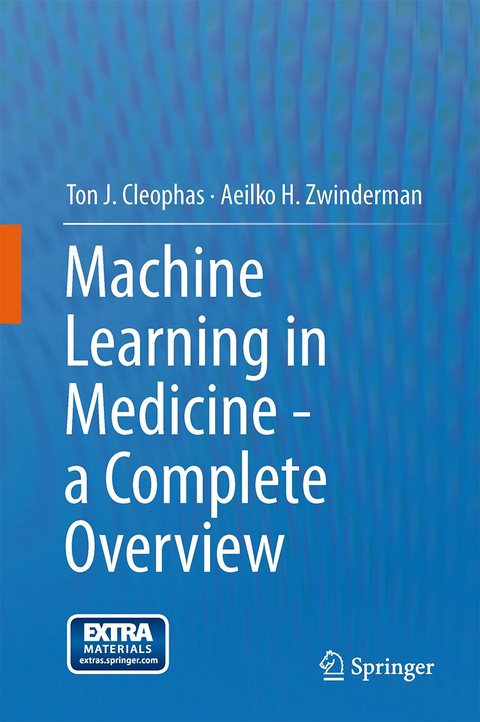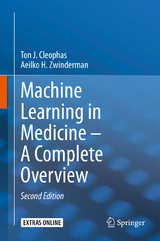
Machine Learning in Medicine - a Complete Overview
Springer International Publishing (Verlag)
978-3-319-15194-6 (ISBN)
- Titel erscheint in neuer Auflage
- Artikel merken
The amount of data stored in the world's databases doubles every 20 months, and clinicians, familiar with traditional statistical methods, are at a loss to analyze them. Traditional methods have, indeed, difficulty to identify outliers in large datasets, and to find patterns in big data and data with multiple exposure / outcome variables. In addition, analysis-rules for surveys and questionnaires, which are currently common methods of data collection, are, essentially, missing. Fortunately, the new discipline, machine learning, is able to cover all of these limitations.
So far medical professionals have been rather reluctant to use machine learning. Also, in the field of diagnosis making, few doctors may want a computer checking them, are interested in collaboration with a computer or with computer engineers. Adequate health and health care will, however, soon be impossible without proper data supervision from modern machine learning methodologies like cluster models, neural networks and other data mining methodologies.
Each chapter starts with purposes and scientific questions. Then, step-by-step analyses, using data examples, are given. Finally, a paragraph with conclusion, and references to the corresponding sites of three introductory textbooks, previously written by the same authors, is given.
Preface. Section I Cluster and Classification Models. - Hierarchical Clustering and K-means Clustering to Identify Subgroups in Surveys (50 Patients).- Density-based Clustering to Identify Outlier Groups in Otherwise Homogeneous Data (50 Patients).- Two Step Clustering to Identify Subgroups and Predict Subgroup Memberships in Individual Future Patients (120 Patients)- Nearest Neighbors for Classifying New Medicines (2 New and 25 Old Opioids)- Predicting High-Risk-Bin Memberships (1445 Families).- Predicting Outlier Memberships (2000 Patients).- Data Mining for Visualization of Health Processes (150 Patients).-8 Trained Decision Trees for a More Meaningful Accuracy (150 Patients).- Typology of Medical Data (51 Patients).- Predictions from Nominal Clinical Data (450 Patients).- Predictions from Ordinal Clinical Data (450 Patients).- Assessing Relative Health Risks (3000 Subjects).- Measurement Agreements (30 Patients).- Column Proportions for Testing Differences between Outcome Scores (450 Patients).- Pivoting Trays and Tables for Improved Analysis of Multidimensional Data (450 Patients).- Online Analytical Procedure Cubes for a More Rapid Approach to Analyzing Frequencies (450 Patients).- Restructure Data Wizard for Data Classified the Wrong Way (20 Patients).- Control Charts for Quality Control of Medicines (164 Tablet Disintegration Times).- Section II (Log) Linear Models.- Linear, Logistic, and Cox Regression for Outcome Prediction with Unpaired Data (20, 55, and 60 Patients).- Generalized Linear Models for Outcome Prediction with Paired Data (100 Patients and 139 Physicians).- Generalized Linear Models for Predicting Event-Rates (50 Patients).- Factor Analysis and Partial Least Squares (PLS) for Complex-Data Reduction (250 Patients).- Optimal Scaling of High-sensitivity Analysis of Health Predictors (250 Patients).- Discriminant Analysis for Making a Diagnosis from Multiple Outcomes (45 Patients).- Weighted Least Squares for Adjusting Efficacy Data with Inconsistent Spread (78 Patients).- Partial Correlations for Removing Interaction Effects from Efficacy Data (64 Patients).- Canonical Regression for Overall Statistics of Multivariate Data (250 Patients).- Multinomial Regression for Outcome Categories (55 Patients).- Various Methods for Analyzing Predictor Categories (60 and 30 Patients).- Random Intercept Models for Both Outcome and Predictor Categories (55 Patients).- Automatic Regression for Maximizing Linear Relationships (55 Patients).- Simulation Models for Varying Predictors (9000 Patients).- Generalized Linear Mixed Models for Outcome Prediction from Mixed Data (20 Patients).- Two Stage Least Squares for Linear Models with Problematic Predictors (35 Patients).- Autoregressive Models for Longitudinal Data (120 Monthly Population Records).- Variance Components for Assessing the Magnitude of Random Effects (40 Patients).- Ordinal Scaling for Clinical Scores with Inconsistent Intervals (900 Patients).- Loglinear Models for Assessing Incident Rates with Varying Incident Risks (12 Populations).- Loglinear Models for Outcome Categories (445 Patients).- Heterogeneity in Clinical Research: Mechanisms Responsible (20 Studies).- Performance Evaluation of Novel Diagnostic Tests (650 and 588 Patients).- Quantile - Quantile Plots, a Good Start for Looking at Your Medical Data (50 Cholesterol Measurements and 52 Patients).- Rate Analysis of Medical Data Better than Risk Analysis (52 Patients).- Trend Tests Will Be Statistically Significant if Traditional Tests Are not (30 and 106 Patients).- Doubly Multivariate Analysis of Variance for Multiple Observations from Multiple Outcome Variables (16 Patients).- Probit Models for Estimating Effective Pharmacological Treatment Dosages (14 Tests).- Interval Censored Data Analysis for Assessing Mean Time to Cancer Relapse (51 Patients).- Structural Equation Modeling with SPSS Analysis of Moment Structures (Amos) for Cause Effect Relationships I (35 Patients).- Structural Equation Modelin
"This is designed to be the first complete overview of machine learning methodologies for the medical and health sector. ... It is targeted primarily at medical and healthcare sector personnel, physicians and students, as well as anyone involved in the process of health and healthcare. ... This is an excellent resource for medical professionals wishing to understand and use machine learning methods." (Kamesh Sivagnanam, Doody's Book Reviews, June, 2015)
| Erscheint lt. Verlag | 10.4.2015 |
|---|---|
| Zusatzinfo | XXIV, 516 p. 159 illus. |
| Verlagsort | Cham |
| Sprache | englisch |
| Maße | 155 x 235 mm |
| Gewicht | 967 g |
| Themenwelt | Mathematik / Informatik ► Mathematik |
| Medizin / Pharmazie ► Allgemeines / Lexika | |
| Medizin / Pharmazie ► Studium | |
| Sozialwissenschaften | |
| Schlagworte | Coputer science • Data Mining • machine learning • SPSS statistical software • various data mining software packages |
| ISBN-10 | 3-319-15194-0 / 3319151940 |
| ISBN-13 | 978-3-319-15194-6 / 9783319151946 |
| Zustand | Neuware |
| Haben Sie eine Frage zum Produkt? |
aus dem Bereich



